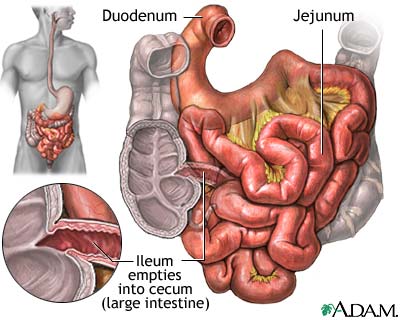small intestine

Location and main sections of the small intestine.

Small intestine cross-section and small-scale structure.
The small intestine is the part of the gastrointestinal tract (GI tract) that extends from the pyloric sphincter to the ileocecal valve, where it empties into the large intestine. The small intestine finishes the process of digestion, absorbs the nutrients, and passes the residue on to the large intestine. The liver, gallbladder, and pancreas are accessory organs of the digestive system that are closely associated with the small intestine.
The small intestine is divided into three sections: the duodenum, jejunum, and ileum. The small intestine follows the general structure of the GI tract in that the wall has a mucosa with simple columnar epithelium, submucosa, smooth muscle with inner circular and outer longitudinal layers, and serosa. The absorptive surface area of the small intestine is increased by plicae circulares, villi, and microvilli.
Exocrine cells in the mucosa of the small intestine secrete mucus, peptidase, sucrase, maltase, lactase, lipase, and enterokinase. Endocrine cells secrete cholecystokinin and secretin.
The most important factor for regulating secretions in the small intestine is the presence of chyme. This is largely a local reflex action in response to chemical and mechanical irritation from the chyme and in response to distention of the intestinal wall. This is a direct reflex action, thus the greater the amount of chyme, the greater the secretion.
Size, location, and structure of the small intestine
jejunum
ileum
Function of the small intestine


